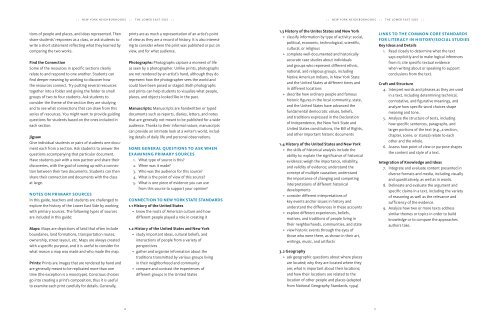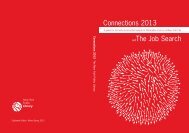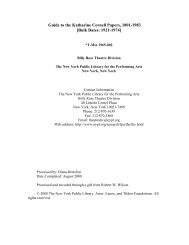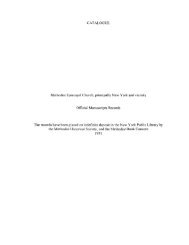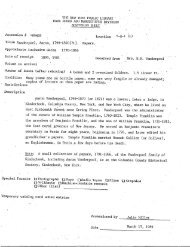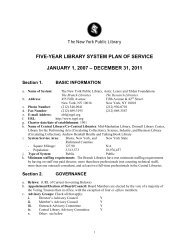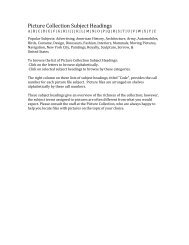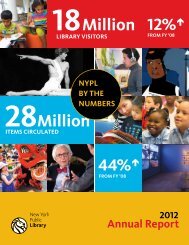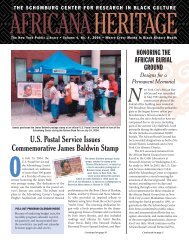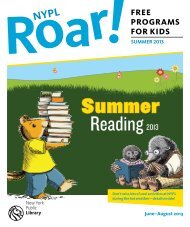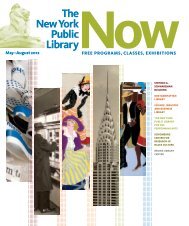Neighborhood Guide: The Lower East Side - New York Public Library
Neighborhood Guide: The Lower East Side - New York Public Library
Neighborhood Guide: The Lower East Side - New York Public Library
Create successful ePaper yourself
Turn your PDF publications into a flip-book with our unique Google optimized e-Paper software.
: : NEW YORK NEIGHBORHOODS : : THE LOWER EAST SIDE : : : : NEW YORK NEIGHBORHOODS : : THE LOWER EAST SIDE : :<br />
tions of people and places, and ideas represented. <strong>The</strong>n<br />
share students’ responses as a class, or ask students to<br />
write a short statement reflecting what they learned by<br />
comparing the two works.<br />
Find the Connection<br />
Some of the resources in specific sections clearly<br />
relate to and respond to one another. Students can<br />
find deeper meaning by working to discover how<br />
the resources connect. Try putting several resources<br />
together into a folder and giving the folder to small<br />
groups of two to four students. Ask students to<br />
consider the theme of the section they are studying<br />
and to see what connections that can draw from this<br />
series of resources. You might want to provide guiding<br />
questions for students based on the ones included in<br />
each section.<br />
Jigsaw<br />
Give individual students or pairs of students one document<br />
each from a section. Ask students to answer the<br />
questions accompanying that particular document.<br />
Have students pair with a new partner and share their<br />
discoveries, with the goal of coming up with a connection<br />
between their two documents. Students can then<br />
share their connection and documents with the class<br />
at large.<br />
NOTES ON PRIMARY SOURCES<br />
In this guide, teachers and students are challenged to<br />
explore the history of the <strong>Lower</strong> <strong>East</strong> <strong>Side</strong> by working<br />
with primary sources. <strong>The</strong> following types of sources<br />
are included in this guide:<br />
Maps: Maps are depictions of land that often include<br />
boundaries, land formations, transportation routes,<br />
ownership, street layout, etc. Maps are always created<br />
with a specific purpose, and it is useful to consider for<br />
what reason a map was made and who made the map.<br />
Prints: Prints are images that are rendered by hand and<br />
are generally meant to be replicated more than one<br />
time (the exception is a monotype). Conscious choices<br />
go into creating a print’s composition, thus it is useful<br />
to examine each print carefully for details. Generally,<br />
prints are as much a representation of an artist’s point<br />
of view as they are a record of history. It is also interesting<br />
to consider where the print was published or put on<br />
view, and for what audience.<br />
Photographs: Photographs capture a moment of life<br />
as seen by a photographer. Unlike prints, photographs<br />
are not rendered by an artist’s hand, although they do<br />
represent how the photographer sees the world and<br />
could have been posed or staged. Both photographs<br />
and prints can help students to visualize what people,<br />
places, and objects looked like in the past.<br />
Manuscripts: Manuscripts are handwritten or typed<br />
documents such as reports, diaries, letters, and notes<br />
that are generally not meant to be published for a wide<br />
audience. Thanks to their informal nature, manuscripts<br />
can provide an intimate look at a writer’s world, including<br />
details of daily life and personal observations.<br />
SOME GENERAL QUESTIONS TO ASK WHEN<br />
EXAMINING PRIMARY SOURCES<br />
1. What type of source is this?<br />
2. When was it made?<br />
3. Who was the audience for this source?<br />
4. What is the point of view of this source?<br />
5. What is one piece of evidence you can use<br />
from this source to support your opinion?<br />
CONNECTION TO NEW YORK STATE STANDARDS<br />
1.1 History of the United States<br />
• know the roots of American culture and how<br />
different people played a role in creating it<br />
1.2 History of the United States and <strong>New</strong> <strong>York</strong><br />
• study important ideas, cultural beliefs, and<br />
interactions of people from a variety of<br />
perspectives<br />
• gather and organize information about the<br />
traditions transmitted by various groups living<br />
in their neighborhood and community<br />
• compare and contrast the experiences of<br />
different groups in the United States<br />
1.3 History of the Unites States and <strong>New</strong> <strong>York</strong><br />
• classify information by type of activity: social,<br />
political, economic, technological, scientific,<br />
cultural, or religious<br />
• complete well-documented and historically<br />
accurate case studies about individuals<br />
and groups who represent different ethnic,<br />
national, and religious groups, including<br />
Native American Indians, in <strong>New</strong> <strong>York</strong> State<br />
and the United States at different times and<br />
in different locations<br />
• describe how ordinary people and famous<br />
historic figures in the local community, state,<br />
and the United States have advanced the<br />
fundamental democratic values, beliefs,<br />
and traditions expressed in the Declaration<br />
of Independence, the <strong>New</strong> <strong>York</strong> State and<br />
United States constitutions, the Bill of Rights,<br />
and other important historic documents<br />
1.4 History of the United States and <strong>New</strong> <strong>York</strong><br />
• the skills of historical analysis include the<br />
ability to: explain the significance of historical<br />
evidence; weigh the importance, reliability,<br />
and validity of evidence; understand the<br />
concept of multiple causation; understand<br />
the importance of changing and competing<br />
interpretations of different historical<br />
developments<br />
• consider different interpretations of<br />
key events and/or issues in history and<br />
understand the differences in these accounts<br />
• explore different experiences, beliefs,<br />
motives, and traditions of people living in<br />
their neighborhoods, communities, and state<br />
• view historic events through the eyes of<br />
those who were there, as shown in their art,<br />
writings, music, and artifacts<br />
3.2 Geography<br />
• ask geographic questions about where places<br />
are located; why they are located where they<br />
are; what is important about their locations;<br />
and how their locations are related to the<br />
location of other people and places (adapted<br />
from National Geography Standards, 1994)<br />
LINKS TO THE COMMON CORE STANDARDS<br />
FOR LITERACY IN HISTORY/SOCIAL STUDIES<br />
Key Ideas and Details<br />
1. Read closely to determine what the text<br />
says explicitly and to make logical inferences<br />
from it; cite specific textual evidence<br />
when writing about or speaking to support<br />
conclusions from the text.<br />
Craft and Structure<br />
4. Interpret words and phrases as they are used<br />
in a text, including determining technical,<br />
connotative, and figurative meanings, and<br />
analyze how specific word choices shape<br />
meaning and tone.<br />
5. Analyze the structure of texts, including<br />
how specific sentences, paragraphs, and<br />
larger portions of the text (e.g., a section,<br />
chapter, scene, or stanza) relate to each<br />
other and the whole.<br />
6. Assess how point of view or purpose shapes<br />
the content and style of a text.<br />
Integration of Knowledge and Ideas<br />
7. Integrate and evaluate content presented in<br />
diverse formats and media, including visually<br />
and quantitatively, as well as in words.<br />
8. Delineate and evaluate the argument and<br />
specific claims in a text, including the variety<br />
of reasoning as well as the relevance and<br />
sufficiency of the evidence.<br />
9. Analyze how two or more texts address<br />
similar themes or topics in order to build<br />
knowledge or to compare the approaches<br />
authors take.<br />
4 5


